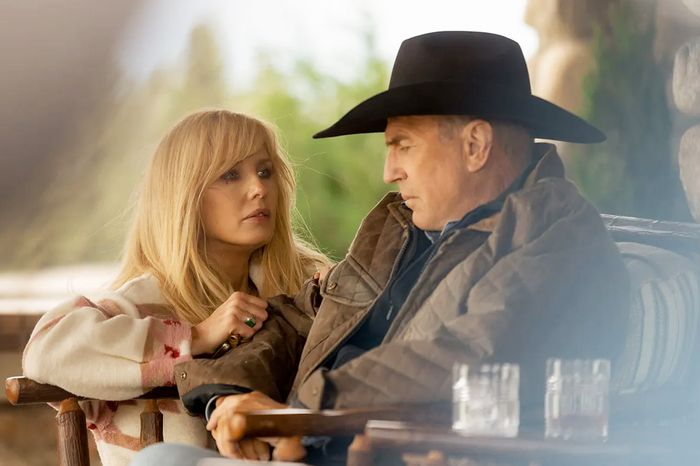
Yellowstone has become so much bigger than just the shows. It represents “real” America, and is often viewed as the only show that caters to the red states. Starring Kevin Costner (seemingly against his will), the show focuses on the Dutton family, Montana landowners who aim to keep their piece, no matter what developers, Indigenous people, or environmentalists say. The only episode I have ever seen of the show (season five’s “The Dream Is Not Me,” which screened before the infamous Paley Fest panel that the feuding Costner and Taylor Sheridan failed to show up for) had three different montages about the Duttons’s vanishing way of life and all the bucolic splendor it affords. Yellowstone isn’t just a show, it’s lifestyle porn. (The Paley Fest attendees in cowboy hats and boots attest to that.)
The Yellowstone brand (pardon the cattle ranching pun) has now extended to a cookbook. Chef Gabriel “Gator” Guilbeau — who went from heading up craft services on set to playing a minor, eponymous part on the show — released Yellowstone: The Official Dutton Ranch Family Cookbook earlier this month. It’s what every dad is getting for Christmas this year, whether they like it or not. The recipes are for food that’s appeared on screen, behind the scenes as food for the cast, and pre-dating the series from his Cajun heritage. “There’s certainly no hiding it,” he told Vulture of his Louisiana roots. “So I absolutely embraced it.” He favors foods that can be cooked over a campfire, as well as meals that can be scaled up to feed a whole cattle drive/TV crew.
To fully immerse myself in the cowboy lifestyle, I let Chef Gator’s flavors take over my life for a weekend to learn how to eat like a Dutton. Unlike its prequels, Yellowstone is about only doing the rustic thing optionally. But I wanted to understand what it is about this vibe that is so appealing to 12 million people, starting with the food most associated with the show. Would the recipe for John, Kayce, and Tate’s glazed venison meatballs help sway this land-back-avowing coastal elite to the Dutton way of life?
A Meal Starts With the Eyes (and the Hands)
The immersion started almost immediately and tactically when I handled the book’s cover, which has a fake-leather finish and the big Yellowstone “Y” branded into it. It was kind of yucky to touch. Already, there is a level of visceral sensory information that is off-putting to my lily-livered greenhorn ass.
Chef Gator favors foods that can be cooked over a campfire, as well as meals that can be scaled up to feed a whole cattle drive/TV crew. The pictures in the book are so appealing, bathed in golden-hour sunlight and smothered in butter.
Beef: It’s What’s for Dinner (and Lunch, and Breakfast)
Would you be shocked to learn that the official cookbook for a show about cattle ranchers has a lot of beef in it? There’s beef chili, rib-eye steak, beef stew, flank steak, pot roast, hamburger mac casserole, and even homemade jerky.
Chef Gator picked recipes that work well over an open flame — say, on a campfire in the middle of Big Sky Country. “Something like a steak needs that incredible amount of heat that you get from a live fire,” he said. “Very few people’s stoves get as hot as I’d like them.” Finishing your steak in an oven just isn’t cowboyish. It’s practically French.
Cast Iron Is King
Speaking of finishing food in an oven, many of the recipes in the Yellowstone cookbook are done in a cast-iron pan. Dishes like the Butter Roasted Shrimp are even served in the pan in which they were cooked. Cast iron pans rule because (1) they look cool, and (2) their versatility. You can sautée in them, shallow fry, or even bake something like cornbread in there. Cast irons can also be used as a weapon, which could come in handy if your life is as conflict-filled as John Dutton’s.
Food Is an Allegory for the Vanishing West
I made two recipes: Rip’s Fry Bread and Rodeo Cowboy Caviar. According to the book, Rip (Cole Hauser) made fry bread for Beth Dutton (Kelly Reilly) after their first night together. It’s a staple in many Native American households. Meanwhile, the roots of cowboy caviar are hotly debated, with some seeing it as Texan heritage, and others calling it gentrified pico de gallo. (The fact that I used store-bought pico as a substitute for Gator’s hand-chopped tomatoes, onions, jalapeños, and cilantro does not help the Texan heritage case.) These two dishes went well together but also spoke to the thorny place Yellowstone has in American culture. It gives roles to Indigenous actors, though some find those roles “Delusional! Deplorable!” It entertains thousands of people but plays on tropes that plague our society and sow division. The cowboy caviar bangs, though. It’s as if a three-bean salad wasn’t gross. Truly groundbreaking.
Really, the Key Is Drinking Like a Dutton
Gator says the most Dutton of dishes is just a big swig of whiskey: “That’s why there are cocktails in the back.” Let’s face it, who has time for elaborate meals (even if you have a personal chef to make them) if you’re busy running for governor, or scheming to steal a baby, or doing whatever it is Jamie does in a day? Next time I make cowboy caviar, I’ll serve it with Beth’s “Two Scoops of Ice Cream, Three Shots of Vodka” smoothie. It’s what Taylor Sheridan would have wanted.



